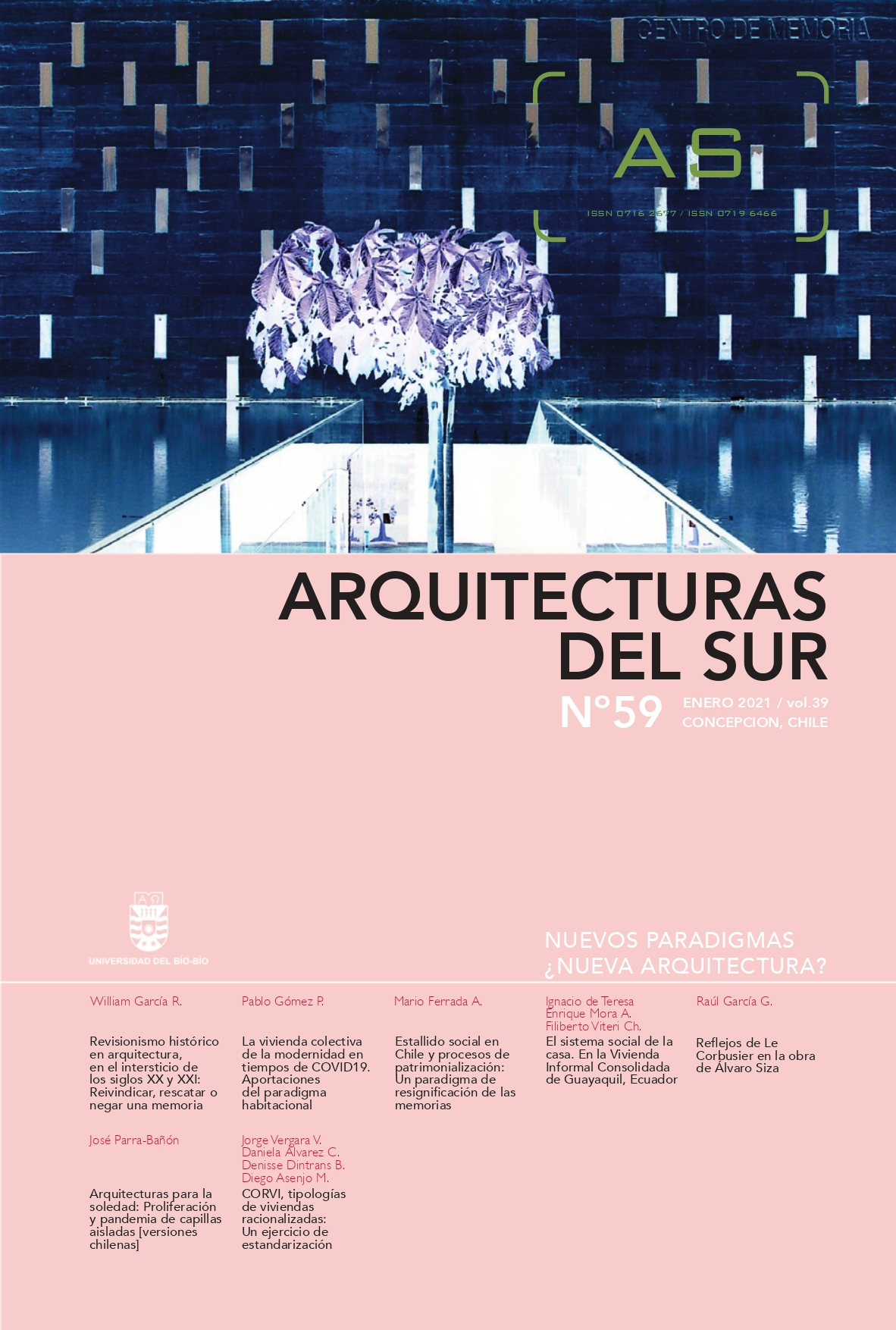O sistema social da casa. No alojamento informal consolidado de Guayaquil síntese
DOI:
https://doi.org/10.22320/07196466.2021.39.059.04Palavras-chave:
Moradia informal, transformação social, concepção de sistemas, coletividade, habitação multifamiliar, objetos multifuncionaisResumo
A crise pós-pandémica da moradia contemporânea, desencadeada pela COVID-19, apenas estende a todo o planeta muitas das questões em que estão permanentemente imersas as casas em crise contínua dos países em desenvolvimento. Surge, portanto, a seguinte questão: como tornar as nossas casas mais partilháveis, flexíveis, transformáveis, produtivas, participativas, habitáveis, etc.? Neste sentido, uma abordagem dos problemas habitacionais de populações de baixa renda nestes países permite analisar alternativas aos modelos de moradia atuais que emergem da informalidade como uma resposta às questões que todos nos colocamos hoje. O seguinte documento descreve parte da pesquisa realizada pela Universidade Católica de Santiago de Guayaquil que analisa as transformações físicas e sociais na estrutura habitacional informal consolidada do centro desta cidade equatoriana. As técnicas utilizadas incluem o levantamento planimétrico de casos de estudo, entrevistas aos usuários e o mapeamento do uso das estruturas ao longo do dia. A análise se centra na interação entre os diferentes núcleos familiares da casa e seus objetos, descrevendo, assim, um sistema de transformação e produção de habitat ligado aos objetos no qual a estrutura habitacional é entendida como um sistema social de objetos e pessoas em contínua interação e transformação.
Downloads
Referências
ALLEN, S. (1999). From object to field. Recuperado de: http://lostritto.com/risd2013spring/wp-content/uploads/2013/04/allen1.pdfv.
APPADURAI, A. (1991). La vida social de las cosas. Perspectiva cultural de las mercancías. México: Grijalbo.
BAUDRILLARD, J. (1969). El sistema de los objetos. Madrid: Siglo XXI.
BENJAMIN, W. (2013). La obra de arte en la época de su reproducción mecánica. Madrid: Casimiro.
CHOMBART DE LAUWE, P. (1960) Famille et Habitation. París, CNRS.
DE MOLINA, S. (2013). La invasión de los objetos. Recuperado de: http://www.santiagodemolina.com/2013/01/la-invasion-de-los-objetos.html.
DE MOLINA, S. (2014). Collage y Arquitectura: la forma intrusa en la construcción del proyecto moderno. Sevilla: Recolectores Urbanos.
DE TERESA, I. (2015). Relación entre las características tipológicas funcionales de la vivienda unifamiliar informal y su evolución espacial. Caso: Santa María de las Lomas, Guayaquil. Guayaquil: SINDE, UCSG.
DE TERESA, I. (2016a). Aproximaciones Familia-Casa: la Vivienda Informal Consolidada en Santa María de las Lomas, Guayaquil. Dearq Revista de Arquitectura, (19), 30-43.
DE TERESA, I. (2016b). Transformaciones incrementales en la vivienda informal consolidada: el caso de Santa María de las Lomas, Guayaquil. Arquitecturas del Sur, 34(49), 6-21.
FRIEDMAN, Y. (1999). Structures serving the unpredictable, Barcelona, Nai Publishers.
GARCÍA-HUIDOBRO, F., TUGAS, N. Y TORRES, D. (2008). El tiempo construye. Lima: Gustavo Gili.
HERNÁNDEZ, F., KELLET, P. Y ALLEN, L.K. (2012). Rethinking the Informal City. Critical perspectives from Latin America.Nueva York: Berghahn Books.
IGLESIA, R. (2011). La vida doméstica y los objetos. Buenos Aires: IAA. Recuperado de: http://www.iaa.fadu.uba.ar/publicaciones/critica/0165.pdf
KOOLHAAS, O. (2011). Project Japan. Metabolism Talks. Chicago: Taschen.
LASH, S. (1999). Objetos que juzgan: el parlamento de las cosas de Latour. Recuperado de: http://eipcp.net/transversal/0107/lash/es.
LATOUR, B. (1993). We have never been modern. Cambridge: Harvard University Press.
MOLES, A. (1975). Teoría de los objetos. Barcelona: Gustavo Gili.
MORA, E., Viteri, F. y De Teresa, I. (2017). Estudio de la Generación de Colectividad en la Vivienda Informal Consolidada”. Caso: Santa María de las Lomas, Guayaquil. Guayaquil: SINDE, UCSG.
MORA, E. (2013). Proceso de crecimiento progresivo de las viviendas y su relación con factores y características de cambio en la estructura y dinámica de las familias de menores ingresos. Guayaquil: SINDE, UCSG.
NIEUWENHUYS, C. (2009). La Nueva Babilonia. Barcelona: GG mínima.
ROSLING, H. (2019). Factfulness. Barcelona: Deusto.
TURNER, J. (2017). John Turner: por una autonomía del habitar. Escritos sobre vivienda, autogestión y holismo. Logroño: Pepita de Calabaza Editores.
VENTURI, R. (1978). Complejidad y contradicción en la arquitectura. Barcelona: Gustavo Gili.
WILENSKY, U. Y RESNICK, M. (1999). Thinking in Levels: a Dynamic Systems Approach to Making Sense of the World. Journal of Science Education and Technology, 8(1), 13-19.
Downloads
Publicado
Como Citar
Edição
Secção
Licença
Direitos de Autor (c) 2021 Ignacio de Teresa, Enrique Mora-Alvarado, Filiberto Viteri-Chávez

Este trabalho encontra-se publicado com a Licença Internacional Creative Commons Atribuição-CompartilhaIgual 4.0.

O conteúdo dos artigos publicados em cada número da Arquitectura del Sur, é de responsabilidade exclusiva dos autores e não representam necessariamente o pensamento, ou compartem a opinião da Universidade de Bío-Bío. Os autores têm seus direitos autorais conservados, e garantiram à revista o direito de primeira publicação e difusão de sua obra. A publicação do artigo na Arquitectura del Sur estará sujeita à Licencia de Reconocimiento de Creative Commons CC BY-SA isso permite que outros se Adaptem: remixam, transformam e constroem o material para qualquer finalidade, inclusive comercialmente, Compartilhe: copie e redistribua o material em qualquer meio ou formato, desde que a autoria e a primeira publicação desta revista sejam reconhecidas, citando-a corretamente , bem como suas novas criações estão sob uma licença com os mesmos termos.













 Programa de Información Científica/Concurso Fondos de Publicación de Revistas Científicas 2018/ Proyecto Mejoramiento de Visibilidad de Revistas UBB (Código:FP180007)
Programa de Información Científica/Concurso Fondos de Publicación de Revistas Científicas 2018/ Proyecto Mejoramiento de Visibilidad de Revistas UBB (Código:FP180007) 
